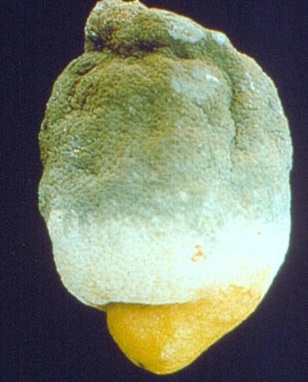Blue & Green Mould: Penicillium digitatum (green mould) and P. italicum (blue mould).
Symptoms
- Softening of damaged tissue.
- White fungal growth, which progressively turns blue or green as spores develop.
- Postharvest fungicides (Imazalil) can arrest spore development resulting in white only fungal growth.
 |
 |
 |
| White fungal growth |
Green spores |
Infected fruits |
Occurrence
- Infections develop from damaged areas.
- The growth of mould increases with storage temperatures (up to an optimum of 27 oC).
- Late season fruit more susceptible.
- Damaged rind is more susceptible.
Management
- Careful handling reduces damage to rind.
- Good hygiene and sorting reduces spore load and infection rates.
- Sanitation destroys spores in recirculating water and packingline equipment.
- Postharvest fungicides should be applied within 24h of harvest.
- Lower storage temperatures slow down fungal development.
Image source: http://www.plantprotection.hu/modulok/angol/citrus/mold_cit.htm |



